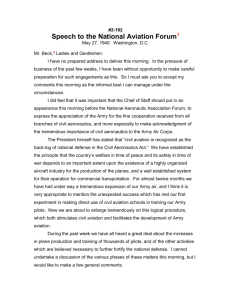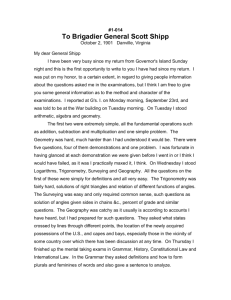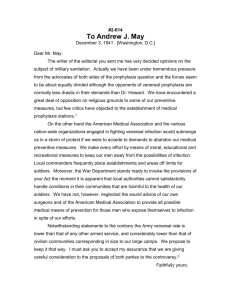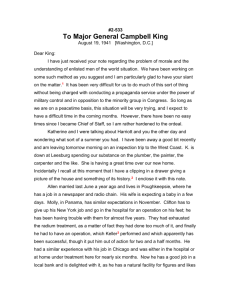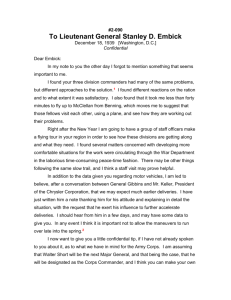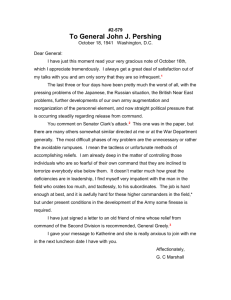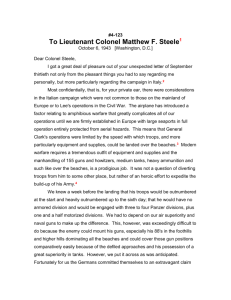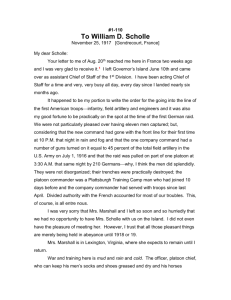5-209 - George C. Marshall Foundation
advertisement
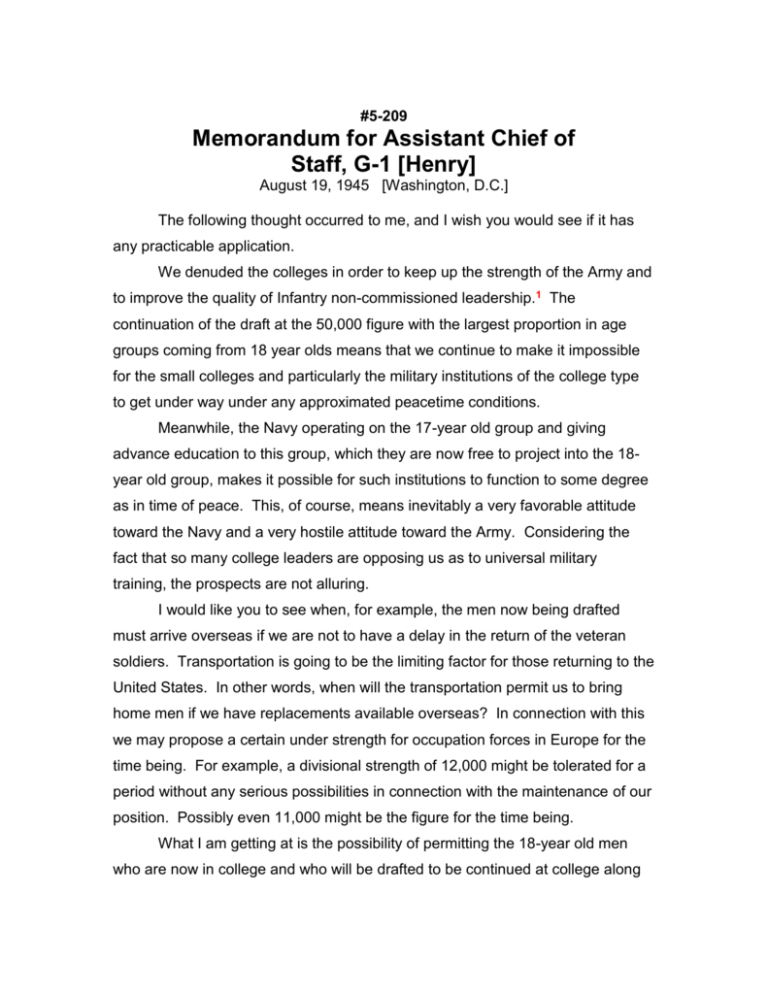
#5-209 Memorandum for Assistant Chief of Staff, G-1 [Henry] August 19, 1945 [Washington, D.C.] The following thought occurred to me, and I wish you would see if it has any practicable application. We denuded the colleges in order to keep up the strength of the Army and to improve the quality of Infantry non-commissioned leadership.1 The continuation of the draft at the 50,000 figure with the largest proportion in age groups coming from 18 year olds means that we continue to make it impossible for the small colleges and particularly the military institutions of the college type to get under way under any approximated peacetime conditions. Meanwhile, the Navy operating on the 17-year old group and giving advance education to this group, which they are now free to project into the 18year old group, makes it possible for such institutions to function to some degree as in time of peace. This, of course, means inevitably a very favorable attitude toward the Navy and a very hostile attitude toward the Army. Considering the fact that so many college leaders are opposing us as to universal military training, the prospects are not alluring. I would like you to see when, for example, the men now being drafted must arrive overseas if we are not to have a delay in the return of the veteran soldiers. Transportation is going to be the limiting factor for those returning to the United States. In other words, when will the transportation permit us to bring home men if we have replacements available overseas? In connection with this we may propose a certain under strength for occupation forces in Europe for the time being. For example, a divisional strength of 12,000 might be tolerated for a period without any serious possibilities in connection with the maintenance of our position. Possibly even 11,000 might be the figure for the time being. What I am getting at is the possibility of permitting the 18-year old men who are now in college and who will be drafted to be continued at college along the line they are engaged in, if it is one suited to our requirements—engineers, communications, medical, etc. We have, I believe, certain 17 year old men in college. Now if their courses have any connection with Army usage, might we not permit their retention in those courses for a certain period of time? If an announcement to this effect were made immediately, it could be put into effect by the schools for the approaching term. Please look into this from the various points of view and be prepared to talk to me informally regarding it Monday afternoon.2 Document Copy Text Source: George C. Marshall Papers, Pentagon Office Collection, Selected Materials, George C. Marshall Research Library, Lexington, Virginia. Document Format: Typed memorandum. 1. The virtual dissolution of the Army Specialized Training Program (A.S.T.P.) in February 1944 permitted Army Ground Forces to obtain seventy-three thousand formerly deferred college men. (See Papers of George Catlett Marshall, #4-241 [4: 286–89], and #4-261–#4-262 [4: 308–11].) The army’s official history on enlisted personnel procurement observed that the A.S.T.P. had been “a series of disillusionments” to the trainees. Moreover, “among civilian educators participating in the ASTP the abrupt termination of their efforts, though accepted as a military necessity, was difficult to understand. It seemed arbitrary, after repeated declarations by the War Department of the importance of specialized training, suddenly to snatch away the young men undergoing such training, a select group numbering only 2 percent of the Army, for conversion into infantry privates.” A key problem was that “the ground combat arms had been persistently denied a proportionate share of high-intelligence personnel” before 1944, and the expansion of ground fighting in late 1943 “made the consequences fully apparent.” (Robert R. Palmer, “The Procurement of Enlisted Personnel: The Problem of Quality,” in Robert R. Palmer, Bell I. Wiley, and William R. Keast, The Procurement and Training of Ground Combat Troops, a volume in the United States Army in World War II [Washington: GPO, 1948], pp. 39, 77.) 2. Selective Service System regulations were amended on September 18, 1945, to provide a more liberal policy regarding deferments for high school and college students. In May 1946, Congress prohibited drafting eighteen- and nineteen-year-olds. (U.S. Selective Service System, Problems of Selective Service, Special Monograph No. 16, vol. 1 [Washington: GPO, 1952], pp. 153–54.) Recommended Citation: The Papers of George Catlett Marshall, ed. Larry I. Bland and Sharon Ritenour Stevens (Lexington, Va.: The George C. Marshall Foundation, 1981– ). Electronic version based on The Papers of George Catlett Marshall, vol. 5, “The Finest Soldier,” January 1, 1945–January 7, 1947 (Baltimore and London: The Johns Hopkins University Press, 2003), pp. 280–281.
